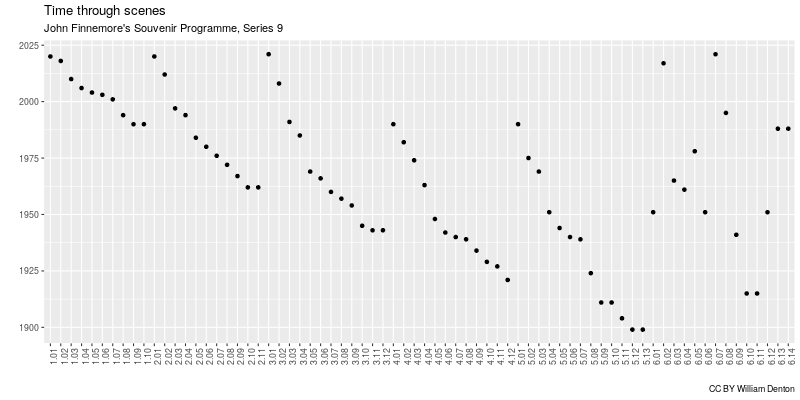I said before that “John Finnemore is doing something incredible with the new series of John Finnemore’s Souvenir Programme.”
I don’t know how Finnemore’s going to end it, but I’m certain it’s going to be good. I think he’s doing something incredible here, and when it ends it will be not just some of his finest work but a radio series that will last forever.
It is. It’s one of the finest things I’ve ever heard on radio. If you haven’t heard it: go listen!
Structurally, it’s six half-hour episodes about an extended family, focusing on five members: mid-thirties parent Russ, his mother Deborah, her father Jerry, his mother Vanessa, and also Uncle Newt, who’s not really an uncle but has been attached to the family for decades. Each episode has scenes that go in reverse chronological order, and the first five episodes move back through the family from Russ to Newt. The sixth is different.
This structure (which really clicks into place with episode three) lets Finnemore tell the story of the family in a delightful way, where we hear unusual sayings or odd family customs long before (to us) we learn how they started. A lot of the show is about this familect. The structure (and how Finnemore chooses the scenes) also means there is no tragedy, because when we learn someone is dead, we know that in a few scenes they will be alive again. This doesn’t mean there is no sadness—there are some heartbreaking scenes—but we don’t follow someone’s life through to their death and then they’re gone, we see fragments of their lives that show how they are made up (sometimes unknowingly) of previous generations and how they in turn shape future generations.
The show doesn’t require repeated listenings, but it does deserve them. It’s not meant to be hard to put the pieces together, and it isn’t—Finnemore said on Twitter he didn’t mean it to be a puzzle—but there is a great pleasure that comes from realizing in a later episode what a small thing in an earlier episode actually meant. Many listeners made their own timelines to better appreciate all this. I did too, and put it all together into a spreadsheet. Then I wanted to see it visually, so I made some charts. Here’s one:

Listen to the six episodes first, then have a look at Analysing the Structure of John Finnemore’s Souvenir Programme, Series 9 (PDF). It’s twelve pages long and includes a lot of code, but you can just look at the charts.
About the show and its structure:
- John Finnemore’s Souvenir Programme might just be a work of radio genius
- Well, Since You Asked Me: detailed summaries of each scene, sortable in episode or chronological order
- A Final Timeline For John Finnemore’s Souvenir Programme Series 9 on Bleeding Cool (lots of ads and trackers; best to avoid)
Some background on a few things, none of which is necessary to know on first listening:
- “A Nightingale Sang in Berkeley Square” has music by Manning Sherwin and lyrics by Eric Maschwitz, who during the war was briefly in the Special Operations Executive. (My favourite recording of the song is by Frank Sinatra on Sinatra Sings Great Songs from Great Britain.)
- Poem codes were indeed used by the SOE, and Leo Marks (sons of the owner of the bookstore in 84 Charing Cross Road) was involved.
- The Boatwomen’s training scheme, or Idle Women, which transported material on narrowboats through the Grand Union Canal.
- For more acts like Midnight and Noone, look up Gwen Farrar and Norah Blaney, or Hetty King, and read Tell Me I’m Forgiven: The Story of Forgotten Stars Gwen Farrar & Norah Blaney by Alison Child.
- In “Woof Woof Woof,” the borzoi is an allusion to “Cousin Teresa” by Saki, and the name “Albert Small” comes from the work of Marriott Edgar (Finnemore said on Twitter his grandmother had a copy of Albert and Balbus and Samuel Small).
- M.R. James begins to tell “The Rose Garden” at the Christmas dinner in 1899.
- For non-UK and Irish listeners, a “lilo” is an air mattress or, as I call it, a floaty toy.
- There’s an inside reference with Acker Bilk’s “Stranger on the Shore,” which Patrick chooses on Desert Island Discs: it was the theme song for That Mitchell and Webb Sound, for which Finnemore wrote. There’s also an anachronism: the song came out in 1961, but Patrick chose it in 1951.
- Some things will bring delight to fans of Finnemore’s earlier show Cabin Pressure: Finnemore here doing an Australian accent for Alex, when back then his character Arthur did a dreadful fake Australian accent; a fruit that sounds like “duh-DUH-duh,” which recalls both memories of a character who was envious of others who had more syllables in their names and also people singing “have a ba-NAH-na” and “level five for family manners being like “code red” to tell Arthur to stop talking.
- “Jawbone” is a wink to Cain’s Jawbone: see also British comedian solves world’s ‘most difficult literary puzzle’ becoming third winner in 100 years.
(UPDATED 18 June 2021 with the “Jawbone” point.)
 Miskatonic University Press
Miskatonic University Press